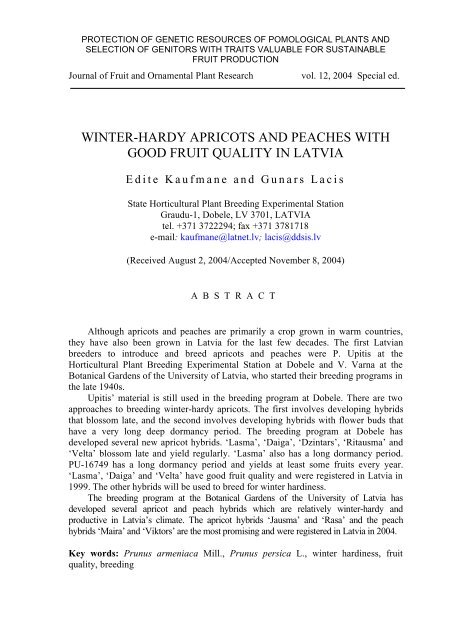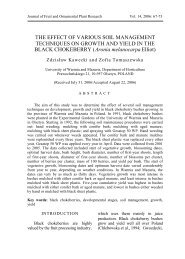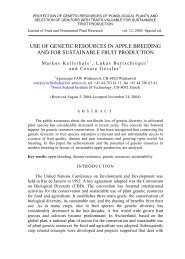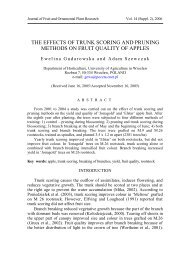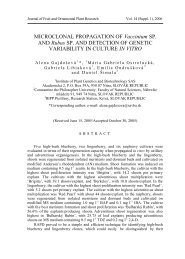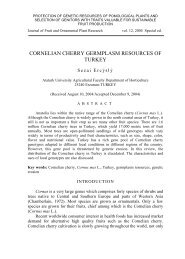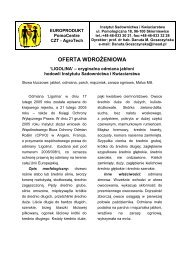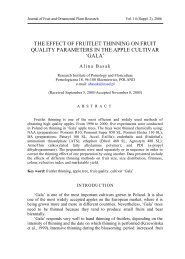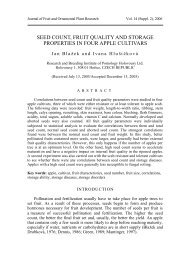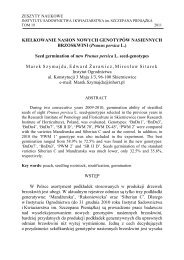Winter-hardy apricots and peaches with good fruit quality in Latvia
Winter-hardy apricots and peaches with good fruit quality in Latvia
Winter-hardy apricots and peaches with good fruit quality in Latvia
Create successful ePaper yourself
Turn your PDF publications into a flip-book with our unique Google optimized e-Paper software.
PROTECTION OF GENETIC RESOURCES OF POMOLOGICAL PLANTS ANDSELECTION OF GENITORS WITH TRAITS VALUABLE FOR SUSTAINABLEFRUIT PRODUCTIONJournal of Fruit <strong>and</strong> Ornamental Plant Researchvol. 12, 2004 Special ed.WINTERHARDY APRICOTS AND PEACHES WITHGOOD FRUIT QUALITY IN LATVIAEdite Kaufmane <strong>and</strong> Gunars LacisState Horticultural Plant Breed<strong>in</strong>g Experimental StationGraudu1, Dobele, LV 3701, LATVIAtel. +371 3722294; fax +371 3781718email: kaufmane@latnet.lv; lacis@ddsis.lv(Received August 2, 2004/Accepted November 8, 2004)ABSTRACTAlthough <strong>apricots</strong> <strong>and</strong> <strong>peaches</strong> are primarily a crop grown <strong>in</strong> warm countries,they have also been grown <strong>in</strong> <strong>Latvia</strong> for the last few decades. The first <strong>Latvia</strong>nbreeders to <strong>in</strong>troduce <strong>and</strong> breed <strong>apricots</strong> <strong>and</strong> <strong>peaches</strong> were P. Upitis at theHorticultural Plant Breed<strong>in</strong>g Experimental Station at Dobele <strong>and</strong> V. Varna at theBotanical Gardens of the University of <strong>Latvia</strong>, who started their breed<strong>in</strong>g programs <strong>in</strong>the late 1940s.Upitis’ material is still used <strong>in</strong> the breed<strong>in</strong>g program at Dobele. There are twoapproaches to breed<strong>in</strong>g w<strong>in</strong>ter<strong>hardy</strong> <strong>apricots</strong>. The first <strong>in</strong>volves develop<strong>in</strong>g hybridsthat blossom late, <strong>and</strong> the second <strong>in</strong>volves develop<strong>in</strong>g hybrids <strong>with</strong> flower buds thathave a very long deep dormancy period. The breed<strong>in</strong>g program at Dobele hasdeveloped several new apricot hybrids. ‘Lasma’, ‘Daiga’, ‘Dz<strong>in</strong>tars’, ‘Ritausma’ <strong>and</strong>‘Velta’ blossom late <strong>and</strong> yield regularly. ‘Lasma’ also has a long dormancy period.PU16749 has a long dormancy period <strong>and</strong> yields at least some <strong>fruit</strong>s every year.‘Lasma’, ‘Daiga’ <strong>and</strong> ‘Velta’ have <strong>good</strong> <strong>fruit</strong> <strong>quality</strong> <strong>and</strong> were registered <strong>in</strong> <strong>Latvia</strong> <strong>in</strong>1999. The other hybrids will be used to breed for w<strong>in</strong>ter hard<strong>in</strong>ess.The breed<strong>in</strong>g program at the Botanical Gardens of the University of <strong>Latvia</strong> hasdeveloped several apricot <strong>and</strong> peach hybrids which are relatively w<strong>in</strong>ter<strong>hardy</strong> <strong>and</strong>productive <strong>in</strong> <strong>Latvia</strong>’s climate. The apricot hybrids ‘Jausma’ <strong>and</strong> ‘Rasa’ <strong>and</strong> the peachhybrids ‘Maira’ <strong>and</strong> ‘Viktors’ are the most promis<strong>in</strong>g <strong>and</strong> were registered <strong>in</strong> <strong>Latvia</strong> <strong>in</strong> 2004.Key words: Prunus armeniaca Mill., Prunus persica L., w<strong>in</strong>ter hard<strong>in</strong>ess, <strong>fruit</strong><strong>quality</strong>, breed<strong>in</strong>g
E. Kaufmane <strong>and</strong> G. LacisINTRODUCTIONAlthough <strong>apricots</strong> <strong>and</strong> <strong>peaches</strong> are primarily a crop grown <strong>in</strong> warmcountries, they have also been grown <strong>in</strong> <strong>Latvia</strong> for the last few decades.Current varieties are not reliable enough for commercial production.Nevertheless, they are grown <strong>in</strong> more <strong>and</strong> more home orchards every yearbecause the <strong>fruit</strong>s are delicious <strong>and</strong> aromatic <strong>and</strong> conta<strong>in</strong> valuable m<strong>in</strong>erals,carotenoids, pect<strong>in</strong>s <strong>and</strong> vitam<strong>in</strong>s.The ma<strong>in</strong> factor limit<strong>in</strong>g the range of apricot cultivation is w<strong>in</strong>terhard<strong>in</strong>ess. Although <strong>apricots</strong> <strong>and</strong> <strong>peaches</strong> can survive quite cold w<strong>in</strong>tertemperatures, they are frequently damaged by frosts <strong>and</strong> cold spells whichoccur after periods of warm weather <strong>in</strong> the spr<strong>in</strong>g. This often happens <strong>in</strong>regions <strong>with</strong> unstable, unpredictable temperatures, such as <strong>Latvia</strong>.The critical temperature for apricot culture is 20°C, at which more than60% of the generative buds are damaged (Smykov, 1989). Commercialapricot production is possible only <strong>in</strong> areas where temperatures drop to 20°C<strong>in</strong> fewer than 20% of the w<strong>in</strong>ters. Commercial apricot production <strong>in</strong> risky <strong>in</strong>areas where temperatures drop to 20°C <strong>in</strong> 20 to 40% of the w<strong>in</strong>ters.Commercial apricot production is not feasible <strong>in</strong> areas where temperaturesdrop to 20°C <strong>in</strong> more than 40% of the w<strong>in</strong>ters.In <strong>Latvia</strong>, commercial apricot <strong>and</strong> peach production are not possiblebecause temperatures drop to 20°C almost every w<strong>in</strong>ter. <strong>Latvia</strong>n breedershave succeeded at develop<strong>in</strong>g cultivars <strong>and</strong> hybrids which survivetemperatures as low as 30°C dur<strong>in</strong>g the deep dormancy phase. However,once the dormancy phase ends, temperatures of only 10°C can be enough todamage flower buds <strong>and</strong> reduce yield.The ma<strong>in</strong> factor contribut<strong>in</strong>g to overall w<strong>in</strong>ter hard<strong>in</strong>ess <strong>in</strong> <strong>apricots</strong> is thew<strong>in</strong>ter hard<strong>in</strong>ess of the flower buds (Klav<strong>in</strong>a <strong>and</strong> Straz<strong>in</strong>ska, 1986; Moore <strong>and</strong>Ball<strong>in</strong>gton, 1989; Smykov, 1989; Straz<strong>in</strong>ska, 1999). Apricot yields aredeterm<strong>in</strong>ed by the hard<strong>in</strong>ess of the generative buds, the length of the deepdormancy period of the buds, <strong>and</strong> how the buds react to w<strong>in</strong>ter thaws <strong>and</strong>subsequent low temperatures.At Dobele, the apricot breed<strong>in</strong>g program has focused on develop<strong>in</strong>gvarieties which flower late <strong>and</strong> have a very long deep dormancy period.The <strong>apricots</strong> grown <strong>in</strong> <strong>Latvia</strong> are smaller than the <strong>apricots</strong> grown <strong>in</strong>warmer countries. For example, the average weight of <strong>Latvia</strong>n <strong>apricots</strong> rangesfrom 21 to 30 grams, <strong>with</strong> a maximum weight of about 50 grams. The averageweight of <strong>apricots</strong> from Hungary, Rumania, Greece, Italy, France <strong>and</strong> Turkeyis 35 grams, <strong>with</strong> a maximum weight of about 85 grams (Akca <strong>and</strong> Sen, 1999;Auergon et al., 1999; Draganesku <strong>and</strong> Cociu, 1999; Szabo et. al., 1999).However, the flavor of several <strong>Latvia</strong>n apricot cultivars <strong>Latvia</strong>n is comparableto the flavor of <strong>apricots</strong> grown <strong>in</strong> warmer countries.322J. Fruit Ornam. Plant Res. Special ed. vol. 12, 2004: 321329
<strong>W<strong>in</strong>ter</strong><strong>hardy</strong> <strong>apricots</strong> <strong>and</strong> <strong>peaches</strong>…<strong>in</strong> <strong>Latvia</strong>At Dobele, the goal of the apricot breed<strong>in</strong>g program has been to developvarieties <strong>with</strong> firm, freestone <strong>fruit</strong>s weigh<strong>in</strong>g from 40 to 55 grams, <strong>with</strong>sweet, juicy, aromatic flesh, low acidity, <strong>and</strong> a soluble solids content of over20%.MATERIAL AND METHODSApricot breed<strong>in</strong>g has been carried out at the Dobele Horticultural PlantBreed<strong>in</strong>g Experimental Station <strong>and</strong> the Botanical Gardens of the University of<strong>Latvia</strong> s<strong>in</strong>ce the late 1940s. The apricot hybrids at Dobele were developed byP. Upitis us<strong>in</strong>g material from the mounta<strong>in</strong>s of Central Asia. The apricothybrids at the Botanical Gardens were developed by V. Varna us<strong>in</strong>g materialfrom the Ukra<strong>in</strong>e, Belarus, the Voronezh district of Russia, <strong>and</strong> from Horog <strong>in</strong>the Pamir Mounta<strong>in</strong>s. Both Upitis <strong>and</strong> Varna used Prunus armeniaca L.(Straz<strong>in</strong>ska, 1999).Because the climate <strong>in</strong> <strong>Latvia</strong> is not favorable for apricot grow<strong>in</strong>g, thema<strong>in</strong> breed<strong>in</strong>g technique used was mass screen<strong>in</strong>g of local openpoll<strong>in</strong>atedseedl<strong>in</strong>gs. Methodical hybridization <strong>with</strong> carefully selected parental formswas used less often because the weather dur<strong>in</strong>g apricot blossom<strong>in</strong>g season isoften <strong>in</strong>clement.Peach breed<strong>in</strong>g <strong>in</strong> <strong>Latvia</strong> was started <strong>in</strong> 1938 by V. Varna, who grewseedl<strong>in</strong>gs from openpoll<strong>in</strong>ated Italian <strong>peaches</strong> <strong>with</strong> large <strong>fruit</strong>s. After twentyyears of work, he developed ‘Latvijas Persiks’, which belongs to the NorthCh<strong>in</strong>a peach group. In <strong>Latvia</strong>, ‘Latvijas Persiks’ is only moderately w<strong>in</strong>ter<strong>hardy</strong>,but has been used <strong>in</strong> later breed<strong>in</strong>g work.The ma<strong>in</strong> breed<strong>in</strong>g technique used <strong>in</strong> the peach breed<strong>in</strong>g program at theBotanical Gardens of the University of <strong>Latvia</strong> was controlled cross<strong>in</strong>g.Seedl<strong>in</strong>gs from the Botanical Gardens were planted <strong>in</strong> a greenhouse together<strong>with</strong> southern varieties such as ‘Vezuvius’, ‘Nikitny’, <strong>and</strong> ‘Nektar<strong>in</strong> Belii’.The hybrid seeds from various comb<strong>in</strong>ations were then planted <strong>in</strong> an openfield. About 2% of the seedl<strong>in</strong>gs survived until they could bear <strong>fruit</strong>. Later,another technique was used <strong>in</strong> which the hybrid seeds were grown <strong>in</strong> pots <strong>and</strong>not transferred outdoors until they were three years old. This producedseedl<strong>in</strong>gs <strong>with</strong> <strong>good</strong>, mature shoots. 98% of the seedl<strong>in</strong>gs survived until theycould bear <strong>fruit</strong> (Straz<strong>in</strong>ska, 1999). Today, the collection of peach cultivars<strong>and</strong> hybrids at the Botanical Gardens <strong>in</strong>cludes fourth <strong>and</strong> fifth generationseedl<strong>in</strong>gs.<strong>W<strong>in</strong>ter</strong> hard<strong>in</strong>ess <strong>in</strong> <strong>apricots</strong> was studied at Dobele from 1992 to 1997.The material studied consisted of third, fourth <strong>and</strong> fifth generation seedl<strong>in</strong>gsdescended from openpoll<strong>in</strong>ated seedl<strong>in</strong>g planted <strong>in</strong> 1959. The fourth <strong>and</strong> fifthgeneration seedl<strong>in</strong>gs were mostly openpoll<strong>in</strong>ated seedl<strong>in</strong>gs of the mostpromis<strong>in</strong>g genotypes.J. Fruit Ornam. Plant Res. Special ed. vol. 12, 2004: 321329 323
E. Kaufmane <strong>and</strong> G. LacisThe follow<strong>in</strong>g criteria were applied <strong>in</strong> select<strong>in</strong>g the most w<strong>in</strong>ter<strong>hardy</strong>apricot hybrids: Late blossom<strong>in</strong>g period; Very long deep dormancy period; Low percentage of frozen buds <strong>in</strong> harsh w<strong>in</strong>ters; <strong>and</strong> High yield.To determ<strong>in</strong>e the length of the deep dormancy period, branches were cut <strong>and</strong>put <strong>in</strong>to a warm room for forc<strong>in</strong>g. This was done start<strong>in</strong>g from the second decadeof January, <strong>and</strong> lasted as long as necessary depend<strong>in</strong>g on weather conditions <strong>and</strong>bud development. The dates of flower bud break were recorded.Weather conditions varied widely from year to year of the study, whichlasted from 1992 to 1999. This provided abundant data for comparison.The w<strong>in</strong>ter of 1992/93 was relatively mild. Air temperatures fromJanuary to March were stable <strong>and</strong> never fell below 15°C. From the firstdecade April, the daily mean temperatures were over +7°C. Dur<strong>in</strong>g the apricotblossom<strong>in</strong>g period, the daily mean temperatures ranged from +3 to +18°C.Marked daily temperature fluctuations occurred only a few times. Once, thetemperature reached +21.2°C dur<strong>in</strong>g the day, <strong>and</strong> +2°C at night. Anothertime, the temperature reached +18°C dur<strong>in</strong>g the day, <strong>and</strong> 2°C at night.In the w<strong>in</strong>ter of 1993/94, January was rather warm (about 10°C), <strong>and</strong>was followed by a very cold February (21.5°C <strong>in</strong> the first decade, <strong>and</strong> 29.6°C <strong>in</strong> the second decade). The third decade of February <strong>and</strong> the firstdecade of March were also colder than normal.The w<strong>in</strong>ter of 1994/95 was mild <strong>and</strong> <strong>with</strong>out significant temperaturefluctuations. The lowest monthly air temperatures were 14°C January, 8.6°C<strong>in</strong> February, <strong>and</strong> 5.5°C <strong>in</strong> March. Dur<strong>in</strong>g the apricot blossom<strong>in</strong>g period <strong>in</strong> thethird decade of April, there were severe temperature fluctuations <strong>and</strong> snowthat did not melt for three days.The w<strong>in</strong>ter of 1995/96 was a typical, stable, cont<strong>in</strong>ental w<strong>in</strong>ter <strong>with</strong> coldtemperatures cont<strong>in</strong>u<strong>in</strong>g from the end of December to the end of March. Them<strong>in</strong>imum temperature <strong>in</strong> February was 36.4°C. Weather conditions werealmost ideal dur<strong>in</strong>g the apricot blossom<strong>in</strong>g period from the end of April to thebeg<strong>in</strong>n<strong>in</strong>g of May. Most days were sunny <strong>with</strong> temperatures rang<strong>in</strong>g from +11to +14°C, <strong>with</strong>out large daily fluctuations.In the w<strong>in</strong>ter of 1996/97, January was cold <strong>with</strong> temperatures down to 26°Cwhen the <strong>apricots</strong> were <strong>in</strong> the deep dormancy period. Mean daily temperaturesranged from 14 to 2°C <strong>in</strong> February <strong>and</strong> from 11 to 1°C <strong>in</strong> March. The first <strong>and</strong>second decades of April were 2 to 3°C below the normal, though some nights thetemperature dropped to 12 to 9°C <strong>and</strong> snow fell. This had negative effect onflower bud development. At the beg<strong>in</strong>n<strong>in</strong>g of the third decade of April, thetemperature was about 0°C, but rose to +10 to +12°C by the end of the decadewhen the apricot blossom<strong>in</strong>g period began. In the first decade of May, the mean airtemperature ranged from +7 to +12°C, <strong>with</strong>out large daily fluctuations.324J. Fruit Ornam. Plant Res. Special ed. vol. 12, 2004: 321329
<strong>W<strong>in</strong>ter</strong><strong>hardy</strong> <strong>apricots</strong> <strong>and</strong> <strong>peaches</strong>…<strong>in</strong> <strong>Latvia</strong>The most promis<strong>in</strong>g apricot <strong>and</strong> peach seedl<strong>in</strong>gs were selected on the basis ofmorphology <strong>and</strong> phenology, <strong>fruit</strong> <strong>quality</strong>, <strong>and</strong> disease resistance. A total of twentycriteria were used <strong>in</strong> select<strong>in</strong>g <strong>apricots</strong>. The criteria were based on descriptor listsapproved by IPGRI (1984) <strong>and</strong> UPOV (1979) for <strong>apricots</strong>, <strong>and</strong> by IPGRI (1985)<strong>and</strong> UPOV (1995) for <strong>peaches</strong>. Local reference cultivars were used for comparison.Eat<strong>in</strong>g <strong>quality</strong> was estimated on the basis of soluble solids content (°Brix).RESULTS AND DISCUSSIONIn <strong>Latvia</strong>, <strong>apricots</strong> are not more widely grown because they do not reliablybear <strong>fruit</strong>, even though the flower bud set is usually abundant. The ma<strong>in</strong> factorlimit<strong>in</strong>g the productivity of apricot trees <strong>in</strong> colder climates is the short deepdormancy period (Straz<strong>in</strong>ska, 1999). The blossom<strong>in</strong>g period <strong>and</strong> the length of thedeep dormancy period vary widely from cultivar to cultivar. Most cultivars have adeep dormancy period that ends at the end of January or the beg<strong>in</strong>n<strong>in</strong>g of February.Apricots go through a forced dormancy period after the deep dormancy periodends. Depend<strong>in</strong>g on the weather <strong>in</strong> a given year, this forced dormancy period couldend as early as the end of January or as late as the end of March (Kaufmane, 1998).The hybrids selected dur<strong>in</strong>g this study had very long deep dormancy periods<strong>and</strong> were not significantly damaged by thaw<strong>in</strong>g <strong>and</strong> subsequent freez<strong>in</strong>g dur<strong>in</strong>g thethird decade of January or the first <strong>and</strong> second decades of February. ‘Lasma’ <strong>and</strong>‘PU16749’ had modest yields even after a w<strong>in</strong>ter <strong>in</strong> which January was warm (10to +5°C) <strong>and</strong> the second decade of February was very cold <strong>with</strong> temperatures downto 29°C.The other ma<strong>in</strong> factor limit<strong>in</strong>g the productivity of apricot trees <strong>in</strong> colderclimates is the early blossom<strong>in</strong>g period. In <strong>Latvia</strong>, <strong>apricots</strong> usually blossom <strong>in</strong> thethird decade of April or the first decade of May. In this study, the earliestblossom<strong>in</strong>g period started on April 18, <strong>and</strong> the latest blossom<strong>in</strong>g period started onMay 10. Depend<strong>in</strong>g on the weather, the blossom<strong>in</strong>g period lasts from 12 to 17 days<strong>in</strong> most years, <strong>and</strong> can last up to 22 days if the weather is exceptionally cool dur<strong>in</strong>gthe blossom<strong>in</strong>g period.The delicate blossoms can be damaged if the temperature falls to 0.5 to 3°Cdur<strong>in</strong>g the blossom<strong>in</strong>g period, depend<strong>in</strong>g on the genotype (Akca <strong>and</strong> Sen, 1999;Draganesku <strong>and</strong> Cociu, 1999; Solovyova, 1967; Straz<strong>in</strong>ska, 1999). The amount ofdamage also depends on how long the temperature stays below this criticaltemperature. If the temperature drops to 2.5 to 2°C for only one or two days, thesepals <strong>and</strong> petals are damaged by frost, but the pistils rema<strong>in</strong> <strong>in</strong>tact. A modest yieldis still possible.Large fluctuations <strong>in</strong> daily temperature can do even more damage. In 1993,when the weather dur<strong>in</strong>g the blossom<strong>in</strong>g period was generally favorable, nighttemperatures dropped to 2°C at one po<strong>in</strong>t, damag<strong>in</strong>g 20 to 100% of the flowerbuds, depend<strong>in</strong>g on genotype. Nevertheless, most genotypes at Dobele had <strong>good</strong>yields that year. Yields may not be significantly reduced even if 20 to 60% ofJ. Fruit Ornam. Plant Res. Special ed. vol. 12, 2004: 321329 325
E. Kaufmane <strong>and</strong> G. LacisTable 1. Characteristics of the best <strong>Latvia</strong>n apricot cultivarsCultivar/hybridAverage <strong>fruit</strong>weight[g]Averageseedweight [g]Solublesolids content[%]‘Lasma’ 27.6 ± 0.9 1.7 ± 0.1 18.2 ± 1.4Sk<strong>in</strong> color FirmnesslightorangemediumfirmShaperoundedSeparation ofstone fromfleshsemifreestone‘Daiga’ 33.6 ± 2.1 2.5 ± 0.2 23.2 ± 1.5 orange firm elongated freestone‘Velta’ 39.8 ± 1.8 2.3 ± 0.2 22.8 ± 1.6 orange‘Ritausma’ 23.2 ± 1.8 1.6 ± 0.2 19.4 ± 1.7‘Dz<strong>in</strong>tars’ 37.3 ± 2.0 1.9 ± 0.1 20.4 ± 1.9darkorangelightorange‘Jausma’ 37.2 ± 1.6 2.3 ± 0.1 23.4 ± 1.6 orangemediumfirmHarvest*Blossom<strong>in</strong>gperiodmidseason midseasonlate midseasonmidseasonrounded freestone midseason midseasonfirm rounded freestonemediumfirmmediumsoftrounded freestone latelate midseasonearlylate midseasonrounded cl<strong>in</strong>gstone late midseason‘Rasa’ 30.7 ± 1.0 2.1 ± 0.1 20.5 ± 1.4 orange firm elongated freestone midseason‘Vita’ 25.6 ± 0.7 1.8 ± 0.1 22.6 ± 1.5 yellow‘Veldze’ 24.9 ± 1.0 1.6 ± 0.1 23.8 ± 1.4PU16749 13.6 ± 0.6 1.7 ± 0.1 16.7 ± 1.4 yellowPU20955 26.8 ± 1.4 1.8 ± 0.1 18.6 ± 1.8PU15029(‘Krista’)24.6 ± 0.2 1.8 ± 0.1 22.2 ± 1.7* early – thirddecade of July or first decade of Augustmidseason – first or second decade of Augustlate midseason – second or thirddecade of Augustlate midseasonearly midseasonearly midseasonorangeyelloworangeyellowmediumsoftmediumsoftmediumfirmmediumfirmrounded freestone midseason earlyrounded freestone midseason earlyroundedroundedlate midseasonorangeyellowsemifreestonefreestonefirm rounded freestoneearlymidseasonmidseason326J. Fruit Ornam. Plant Res. Special ed. vol. 12, 2004: 321329
<strong>W<strong>in</strong>ter</strong><strong>hardy</strong> <strong>apricots</strong> <strong>and</strong> <strong>peaches</strong>…<strong>in</strong> <strong>Latvia</strong>the flowerer buds are damaged, especially on trees which have an abundantset of flower buds (Klav<strong>in</strong>a <strong>and</strong> Straz<strong>in</strong>ska, 1986; Solovyova, 1967).Based on the percentage of flower bud damage <strong>in</strong> 1997, the hybrids mosttolerant to large fluctuations <strong>in</strong> daily temperature were 0240329 (20%),0240851 (32%), <strong>and</strong> PU20955 (35%). These hybrids can be used as donorsof w<strong>in</strong>ter hard<strong>in</strong>ess <strong>in</strong> future breed<strong>in</strong>g programs.Regardless of weather conditions, ‘Lasma’, ‘Daiga’, ‘Ritausma’, ‘Dz<strong>in</strong>tars’,<strong>and</strong> ‘U 08248’ blossomed later than the other hybrids <strong>and</strong> cultivars <strong>in</strong> every yearof the study. They bore <strong>fruit</strong> <strong>in</strong> even the least favorable years.<strong>W<strong>in</strong>ter</strong><strong>hardy</strong> genotypes seldom have <strong>good</strong> <strong>fruit</strong> <strong>quality</strong>. Longer deepdormancy periods <strong>and</strong> later blossom<strong>in</strong>g periods are typical of wild apricotgenotypes, which generally have small <strong>fruit</strong>s of <strong>in</strong>ferior <strong>quality</strong> (Acka <strong>and</strong>Sen, 1999).The breed<strong>in</strong>g programs at the Horticultural Plant Breed<strong>in</strong>g ExperimentalStation at Dobele <strong>and</strong> the Botanical Gardens of the University of <strong>Latvia</strong> havedeveloped several apricot genotypes cultivars <strong>and</strong> hybrids which are relativelyadapted to the <strong>Latvia</strong>n climate <strong>and</strong> have <strong>good</strong> or satisfactory <strong>fruit</strong> <strong>quality</strong>(Tab. 1). Average <strong>fruit</strong> weight ranges from 13.6 to 39.8 g, average seedweight ranges from 1.6 to 2.5 g, <strong>and</strong> soluble solids content ranges from 14 to24%. Most have attractive <strong>fruit</strong>s <strong>with</strong> <strong>good</strong> separation of the stones from theflesh.Table 2. Characteristics of the best <strong>Latvia</strong>n peach cultivarsCultivar‘Maira’Average<strong>fruit</strong> weight[g]Sk<strong>in</strong>colorBlush85.7 ± 7.4 yellow largeFleshcolor‘Viktors’ 84.7 ± 5.2 yellow medium white‘ZiemeļuPersiks’67.7 ± 4.3‘Zelda’ 65.0 ± 2.1‘Rita’ 82.3 ± 7.2‘LatvijasPersiks’**97.7 ± 1.5greenishcreamgreenishcreamFirmnessmediumsoftsoftHarvest*earlylowmediummedium white soft late highlargelargeResistancetoTaphr<strong>in</strong>adeformanswhitecreammidseasonwhitecreamlatemidseasoncreamyellowcreamyellowyellowgreenishsoftmediumsoft late mediummedium yellow medium late* early – thirddecade of July or first decade of Augustmidseason – first or second decade of Augustlate midseason – secondor thirddecade of Augustlate – thirddecade of August or firstdecade of September** can be grown only <strong>in</strong> a greenhousemediumJ. Fruit Ornam. Plant Res. Special ed. vol. 12, 2004: 321329 327
E. Kaufmane <strong>and</strong> G. LacisThe most promis<strong>in</strong>g new apricot cultivars were ‘Lasma’, ‘Daiga’, ‘Velta’,which were registered <strong>in</strong> <strong>Latvia</strong> <strong>in</strong> 1999, <strong>and</strong> ‘Jausma’ <strong>and</strong> ‘Rasa’, which wereregistered <strong>in</strong> 2004.Peaches have a long vegetative period <strong>and</strong> a short deep dormancy period.In <strong>peaches</strong>, w<strong>in</strong>ter hard<strong>in</strong>ess is determ<strong>in</strong>ed by many factors, <strong>in</strong>clud<strong>in</strong>grootstock, temperature <strong>and</strong> humidity dur<strong>in</strong>g the previous summer, yield,frequency of w<strong>in</strong>ter thaws, temperatures dur<strong>in</strong>g critical developmental periods<strong>in</strong> the spr<strong>in</strong>g, <strong>and</strong> disease resistance (Straz<strong>in</strong>ska, 1999).The breed<strong>in</strong>g program at the Botanical Gardens of the University of<strong>Latvia</strong> has developed several promis<strong>in</strong>g peach cultivars <strong>and</strong> hybrids (Tab. 2).They are relatively w<strong>in</strong>ter<strong>hardy</strong>, <strong>with</strong> <strong>good</strong> yields of <strong>good</strong> <strong>quality</strong> <strong>fruit</strong>. Theyare generally resistant to leaf curl (Taphr<strong>in</strong>a deformans), the most importantpeach disease <strong>in</strong> <strong>Latvia</strong>. Average <strong>fruit</strong> weight ranges from 60 to 100 g. Mostof these peach cultivars <strong>and</strong> hybrids have <strong>good</strong> separation of the stones fromthe flesh.The most promis<strong>in</strong>g new peach cultivars were ‘Maira’ <strong>and</strong> ‘Viktors’,which were registered <strong>in</strong> <strong>Latvia</strong> <strong>in</strong> 2004.REFERENCESAkca Y., Sen S.M. 1999. Studies on selection of <strong>apricots</strong> <strong>with</strong> <strong>good</strong> <strong>fruit</strong><strong>quality</strong> <strong>and</strong> resistance to late spr<strong>in</strong>g frosts <strong>in</strong> Gevas Pla<strong>in</strong>. ACTA HORT. 488:135137.Audergon J.M, Chauffour D., Clauzel G., Duffillol J.M.,Gilles F., Broquaire J.M., Esteve L. 1999. Apricot breed<strong>in</strong>g <strong>in</strong>France: Two new apricot selections for French growers. ACTA HORT. 488:143149.Draganescu E., Cociu V. 1999. The moderniz<strong>in</strong>g of the apricot assortmentof cultivars <strong>in</strong> the Banat Area of Romania. ACTA HORT. 488: 149153.IPGRI 1984. Apricot Descriptors. In: R. Guerriero, R. Watk<strong>in</strong>s (eds), IBPGRSecretariat, Rome, 36 p.IPGRI 1985. Peach Descriptors. In: E. Bell<strong>in</strong>i, R. Watk<strong>in</strong>s, E. Pomarici (eds),IBPGR Secretariat, Rome, 36 p.Kaufmane E. 1998. Apricot breed<strong>in</strong>g for w<strong>in</strong>ter hard<strong>in</strong>ess. Horticulture <strong>and</strong>vegetable grow<strong>in</strong>g. 17(3): 173178.Klav<strong>in</strong>a Z., Straz<strong>in</strong>ska I. 1986. Biological <strong>and</strong> commercial evaluation ofapricot selections. Tautsaimnieciba derigo augu agrotehnika un biologija. Riga,pp. 5263.Moore N.J., Ball<strong>in</strong>gton J.R. 1989. Apricots (Prunus). Genetic resourcesof temperate <strong>fruit</strong> <strong>and</strong> nut crops I, Wagen<strong>in</strong>gen, Netherl<strong>and</strong>s, pp. 6597.Smykov V.K. 1989. The Apricot. Moscow, 240 p.Solovyova M. 1967. <strong>W<strong>in</strong>ter</strong> hard<strong>in</strong>ess of <strong>fruit</strong> crops by different grow<strong>in</strong>gconditions. Moscow, 124 p.328J. Fruit Ornam. Plant Res. Special ed. vol. 12, 2004: 321329
<strong>W<strong>in</strong>ter</strong><strong>hardy</strong> <strong>apricots</strong> <strong>and</strong> <strong>peaches</strong>…<strong>in</strong> <strong>Latvia</strong>Straz<strong>in</strong>ska I. 1999. Apricot <strong>and</strong> peach varieties selected at the Botanical gardensof the University of <strong>Latvia</strong>. Proc. Int. Conf. Fruit Grow<strong>in</strong>g Today <strong>and</strong>Tomorrow, Dobele, <strong>Latvia</strong>, 1999, pp. 3441.Szabo Z., Nyeki J., Andrasfalvy A., Szalay L., Pedryc A.1999. Evaluation of some Romanian apricot varieties <strong>in</strong> Hungary. ACTA HORT.488: 211215.UPOV 1979. Guidel<strong>in</strong>es for the Conduct of Tests for Dist<strong>in</strong>ctness, Uniformity <strong>and</strong>Stability, TG/70/3, Apricots, (Prunus armeniaca L.), 22 p.UPOV 1995. Guidel<strong>in</strong>es for the Conduct of Tests for Dist<strong>in</strong>ctness, Uniformity <strong>and</strong>Stability, TG/53/6, Peaches <strong>and</strong> Nectar<strong>in</strong>es, (Prunus persica (L.) Batsch.), 30 p.HODOWLA MROZOODPORNYCH I DOBRYCHJAKOŚCIOWO ODMIAN MORELI I BRZOSKWINI NAŁOTWIEEdite Kaufmane i Gunars LacisSTRESZCZENIEChociaż morele i brzoskw<strong>in</strong>ie pochodzą z południowych rejonów, uprawiane sąna Łotwie od dawna. Pierwszymi propagatorami ich uprawy oraz hodowcami byli: V.Varna z Ogrodów Botanicznych Uniwersytetu Łotewskiego oraz P. Upitis ze StacjiHodowli Rośl<strong>in</strong> Ogrodniczych w Dobele (Dobele HPBES). Rozpoczęli oni pracehodowlane w końcu lat 40. ubiegłego wieku. Prace te są obecnie kontynuowanew Stacji Dobele opierając się na materiale hodowlanym P. Upitis. Hodowla moreliprowadzona jest w dwu kierunkach, to jest uzyskania późno kwitnących mieszańcóworaz mieszańców o długim okresie spoczynku. Wyselekcjonowano 5 późnokwitnących regularnie owocujących odmian: ‘Lasma’, ‘Daiga’, ‘Dz<strong>in</strong>tars’,‘Ritausma’ i ‘Velta’ oraz o wydłużonym okresie spoczynku – ‘Lasma’ i klon PU16749, które plonują corocznie. Odmiany ‘Lasma’, ‘Daiga’ i ‘Velta’ rodzą owocedobrej jakości i zostały wpisane do Rejestru w 1999 roku. Pozostałe klony będąwykorzystane w dalszych pracach hodowlanych.W wyniku wieloletnich prac hodowlanych prowadzonych w Ogrodzie BotanicznymUniwersytetu Łotewskiego uzyskano mrozoodporne odmiany moreli i brzoskw<strong>in</strong>i.Najlepsze z nich to morele ‘Jausma’ i ‘Rasa’ oraz brzoskw<strong>in</strong>ie ‘Maira’ i ‘Victors’.Odmiany te wpisano do Rejestru w 2004 roku.Słowa kluczowe: morela, brzoskw<strong>in</strong>ia, mrozoodporność, jakość owoców, hodowlaJ. Fruit Ornam. Plant Res. Special ed. vol. 12, 2004: 321329 329


